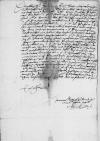Dem durchlauchten, hochgebornen fursten und herren, hern ⌊Albrechten⌋, von Gots gnaden marggraff zu ⌊Bran[den]burg⌋, in ⌊Preussen⌋, zu ⌊Stettin⌋, [⌊Pommern⌋], der ⌊Cassuben⌋ und ⌊Wenden⌋ [hertzog, bur]ggraff zu ⌊Normberg⌋ [und] [furst] zu ⌊Rugen⌋, / unserm [hochgunsti]gen, lieben herren und freundt
Durchlauchterr her[r] ... []nerr furst, / hohgunstigerr und vilgeliebterr herrr und fre[undt]. / Mein freuntliche und gancz fleisgewilgete(!) dienst zuvorann. /
Den edlenn, ernfesthen hern ⌊Jorgen von Kunhaim⌋, Ewer Furstlichen Herlichkeit radt und houptmann zu ⌊Tapiau⌋, hab ich in beywesenn des hern ⌊danczker castellans⌋ vonn Ewer Furstlichen Durchlaucht wegenn gernn gesehenn / und der hochwerstendigenn sorgfeldigheit halbenn, die Ewer Furstliche Durchlaucht zu ⌊koniglicher maiestet⌋, unserem allergnedigsten hern, / der ⌊Cron⌋ / und zu uns allenn / tregt, / vil lieber gehort / in dem, das vortrawterr weis Ewer Furstliche Durchlaucht an mich und gedochtenn hern castellann hot lossenn gelangenn, / daruff wir samptlich / hochdanckende Ewer Furstliche Durchlaucht der zuvorsicht, die sie zu uns beidenn hath, / noch unsermm slechtemm vorstant / gemeltem hern von ⌊Kunhaim⌋ / unser einfeltig bedenckenn / an Ewer Furstliche Durchlaucht zu tragenn habenn gebetenn, / der nicht an sondren fleis / mit tifsyngrer ausredung / und geschicklicheit sich mit demm hern castellan unnd mir, / was durch in an Ewer Furstliche Durchlaucht gelangenn sol, / hot entslossenn, / Ewer Furstliche Durchlaucht noch irem furstlichenn hochemm vorstant / und der gnadenn, die Got der almechtig Ewer Durchlaucht gegebenn, / wirt sich in allemm wol wissenn zuentrichtenn. / Was mich belangt, / bleib ich im vorigenn erbittenn wie der, der Ewer Furstlichen Durchlaucht freuntlich, / nuczlich und williglich zu dinenn gancz geflissen ist und begirig, / in der gunst ... mich ouch vertraulich thue befelenn.
... ⌊[Hei]lsberg⌋, den 15 Februarii 1540.
Ewer Furstlichen Durchlaucht williger
⌊Ioannes⌋ etc. bischoff zu ⌊Ermelandt⌋ manu propria scripsi



